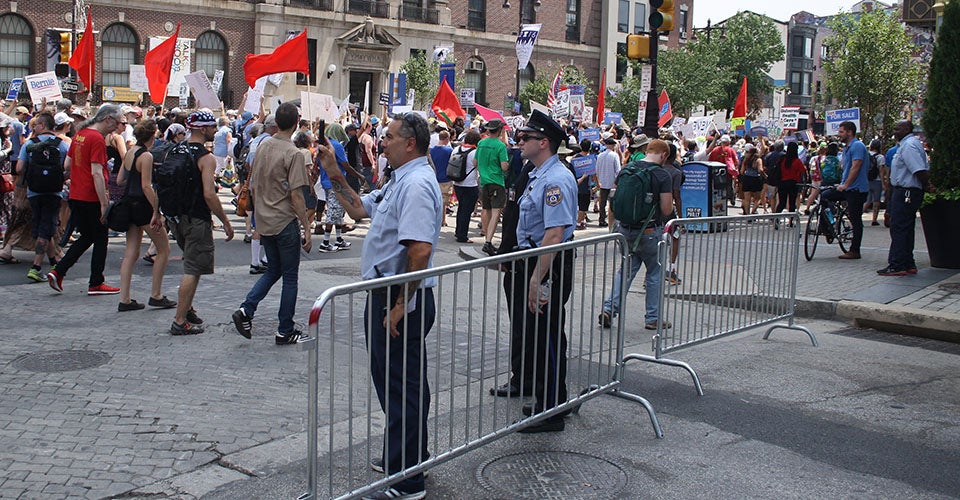MARCH MANAGEMENT
ECU researchers track evolution of policing protests
After attending both major political conventions this summer, an East Carolina University sociology professor is shaping new research around large-scale protests and police response tactics.
There is a continuous adaptation and evolution between large-scale protesters and the police dispatched to keep them under control, said Dr. Bob Edwards. “It’s sort of a dance, where each side is aware of what the other is doing, and adjusts.”
Edwards is working with a team of sociology and criminal justice faculty and students that hails from several institutions – ECU, Western Washington University, University of Wisconsin-La Crosse and Arcadia University – and has been observing and documenting protests since 2001. They monitor the web pages and social media of both protest groups and police in order to attend planned and spontaneous protest events.
There’s a delicate and constantly shifting balance between security and free expression, Edwards said. “In many ways, in many people’s minds, those are competing ideas, which is one of the broader ideas of this research.”

A small group of protesters in Cleveland is ringed by police, who are surrounded by multiple rings of press.
After attending protest events each day during the political conventions, the team met to talk through what they’d seen and plan for the following day. Now that the conventions are over, they have a massive amount of notes and photos to sort through, but several observations stood out.
“In both cities the protests and the policing of them remained overwhelmingly peaceful with relatively few instances of conflict or overt contention between police and protesters,” Edwards said. There was one significant episode of contention between police and protesters in Philadelphia, but it was mild compared to past political conventions during the Iraq War, Global Justice protests during the 2000s or the Occupy Wall Street movement of 2011, he added.
There was a noticeable difference in the approaches to policing between the two conventions, with a much larger police presence in Cleveland. Edwards said the city of Philadelphia took measures to reduce the number of arrests after facing lawsuits related to the arrests made during past protest events.
“A number of actions the Philadelphia police had previously arrested protesters for were decriminalized for the DNC, indicating a more hands-off policing strategy,” he said. “A new citation system was also implemented allowing the police to detain protesters, remove them from the scene, and then issue misdemeanor citations without a formal arrest.
“By the third day of protests around the DNC, activists prone to acts of disruptive but non-violent, non-destructive acts of civil disobedience as a way to express the intensity of their grievances seemed to have figured out the new policing strategy.”
During a pre-demonstration meeting of activists Edwards observed a discussion of how few arrests were being made and what demonstrators would have to do to be arrested, short of violence or property damage.
“Current demonstrators were adapting to a new police strategy, which itself was an adaptation to lawsuits brought by previous demonstrators over prior protest policing strategy,” Edwards said.
In Cleveland, approximately 300 bicycle officers were used extensively to manage protesters and bystanders, forming mobile barricade lines to steer marchers into pre-defined routes, forming rings around groups of protesters to separate them from each other or from their audience, and riding through or near small groups of protesters to make their presence known.
“By the third day of the RNC, several activists were observed accompanying protest marches, themselves on bicycles,” Edwards said. “They rode in ways that disrupted the bike officers’ ability to ride in formation. They seemed to be assessing, experimenting.
“As police make more use of bicycle officers, my colleagues and I expect to see more protesters on bicycles testing the limits of this emerging police tactic, thinking of ways to incorporate bicycles into protests, developing new ways to impede or disrupt police efforts to control future protests.”
The most surprising aspect of the two sets of protests for Edwards and the team was the lack of protest and contention in Cleveland, compared to expectations and to the massive police presence. Several thousand officers were brought in from at least 20 different states to assist the city’s police department.
“We have not yet fully compiled our data,” he said, “but I think that police significantly outnumbered protesters at most events. The magnitude of officers deployed to small protest events in Cleveland far exceeded deployments in Philadelphia for comparable or even larger events.
“Similarly, the amount of press personnel on hand in Cleveland seemed equally excessive … The press presence at times overwhelmed protest actions and impeded police efforts to manage events.”
As the group’s notes and photographs are organized and annotated, the members will compare the two events and look for illustrations of changes in strategy and of how the two police agencies worked differently.
“We are already outlining research articles to write based on the work,” Edwards said. “I will be working on developing a presentation on the RNC-DNC project and its background, as well as ways to incorporate some of this into the Department of Sociology website.”

Police block a street in Philadelphia during a protest march.
